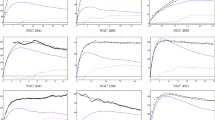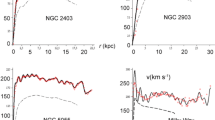Abstract
The logarithmic superfluid theory of physical vacuum predicts that gravity is an induced phenomenon, which has a multiple-scale structure. At astronomical scales, as the distance from a gravitating center increases, gravitational potential and corresponding spacetime metric are dominated by a Newtonian (Schwarzschild) term, followed by a logarithmic term, finally by linear and quadratic (de Sitter) terms. Correspondingly, rotation curves are predicted to be Keplerian in the inner regions of galaxies, mostly flat in the outer regions, and non-flat in the utmost outer regions. We compare theory’s predictions with the furthest rotation curves data points available for a number of galaxies: using a two-parameter fit, we perform a preliminary estimate which disregards the combined effect of gas and stellar disc, but is relatively simple and uses minimal assumptions for galactic luminous matter. The data strongly points out at the existence of a crossover transition from flat to non-flat regimes at galactic outskirts.

Similar content being viewed by others
REFERENCES
V. C. Rubin, W. K. Ford, Jr., and N. Thonnard, Astrophys. J. 238, 471 (1980).
P. A. M. Dirac, Nature (London, U.K.) 168, 906 (1951).
G. E. Volovik, The Universe in a Helium Droplet (Clarendon, Oxford, 2003).
K. Huang, A Superfluid Universe (World Scientific, Singapore, 2016).
K. G. Zloshchastiev, Grav. Cosmol. 16, 288 (2010); arXiv: 0906.4282.
K. G. Zloshchastiev, Acta Phys. Polon. B 42, 261 (2011); arXiv: 0912.4139.
K. G. Zloshchastiev, Phys. Lett. A 375, 2305 (2011); arXiv: 1003.0657.
V. Dzhunushaliev and K. G. Zloshchastiev, Centr. Eur. J. Phys. 11, 325 (2013); arXiv: 1204.6380.
K. G. Zloshchastiev, Int. J. Mod. Phys. B 33, 1950184 (2019); arXiv: 2001.04688.
K. G. Zloshchastiev, Int. J. Mod. Phys. A 35, 2040032 (2020); arXiv: 2011.11897.
K. G. Zloshchastiev, Universe 6, 180 (2020); arXiv: 2011.12565.
K. G. Zloshchastiev, Low Temp. Phys. 47, 89 (2021); arXiv: 2103.00818.
L. Zhang and W. Hou, Appl. Math. Lett. 102, 106149 (2020). https://doi.org/10.1016/j.aml.2019.106149
C. J. C. O. Alves, Discrete Contin. Dyn. Syst. 40, 2671 (2020).
J. Shertzer and T. C. Scott, J. Phys. Commun. 4, 065004 (2020).
T. Boudjeriou, J. Elliptic Parabolic Equat. 6, 773 (2020).
F. C. E. Lima and C. A. S. Almeida, Europhys. Lett. 131, 31003 (2020). https://doi.org/10.1209/0295-5075/131/31003
Z. Zhou and Z. Yan, Phys. Lett. A 387, 127010 (2021); arXiv: 2012.02979.
Q. Yang and C. Bai, AIMS Math. 6, 868 (2021).
K. G. Zloshchastiev, Zeitschr. Naturf. A 73, 619 (2018). https://doi.org/10.1515/zna-2018-0096
K. G. Zloshchastiev, Eur. Phys. J. B 85, 273 (2012); arXiv: 1204.4652.
T. C. Scott and K. G. Zloshchastiev, Low Temp. Phys. 45, 1231 (2019); arXiv: 2006.08981.
K. Pardo and D. N. Spergel, Phys. Rev. Lett. 125, 211101 (2020); arXiv: 2007.00555.
P. D. Mannheim and D. Kazanas, Astrophys. J. 342, 635 (1989).
D. Grumiller, Phys. Rev. Lett. 105, 211303 (2010); arXiv: 1011.3625.
H.-N. Lin, M.-H. Li, X. Li, and Z. Chang, Mon. Not. R. Astron. Soc. 430, 450 (2013); arXiv: 1209.3532.
A. Toomre, Astrophys. J. 138, 385 (1963).
S. Casertano, Mon. Not. R. Astron. Soc. 203, 735 (1983).
ACKNOWLEDGMENTS
Proofreading of the manuscript by P. Stannard is greatly appreciated.
Funding
This work is based on the research supported by Department of Higher Education and Training of South Africa, and in part by the National Research Foundation of South Africa (Grants Nos. 95965, 131604 and 132202).
Author information
Authors and Affiliations
Corresponding author
Additional information
Paper presented at the Fourth Zeldovich meeting, an international conference in honor of Ya.B. Zeldovich held in Minsk, Belarus, on September 7–11, 2020. Published by the recommendation of the special editors: S.Ya. Kilin, R. Ruffini, and G.V. Vereshchagin.
Rights and permissions
About this article
Cite this article
Zloshchastiev, K.G. On Asymptotic Behavior of Galactic Rotation Curves in Superfluid Vacuum Theory. Astron. Rep. 65, 1078–1083 (2021). https://doi.org/10.1134/S1063772921100437
Received:
Revised:
Accepted:
Published:
Issue Date:
DOI: https://doi.org/10.1134/S1063772921100437




